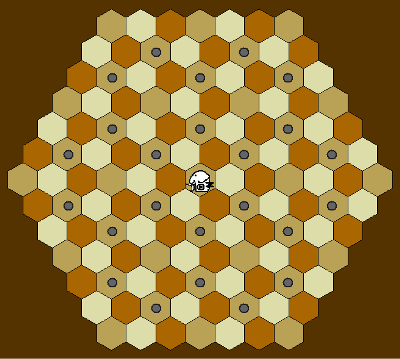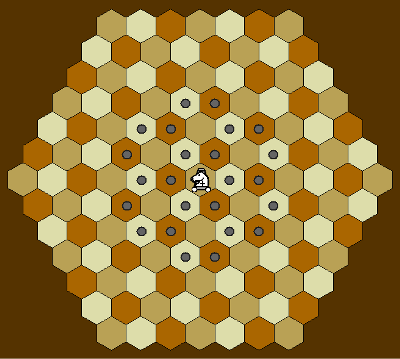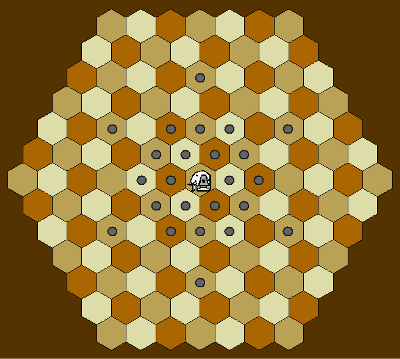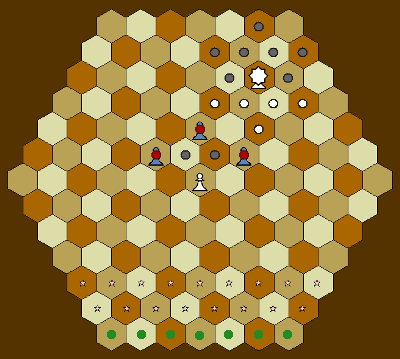Atlantean Coffee House Shatranj
It has been written:"Atlantis was a city, island, and culture with many facets. The old and new nobility, along with the members of the merchant class with both wealth and aspirations, played Great Shatranj, a sedate, traditional old game. The young people, the intellectuals and artists, and the non-wealthy members of the merchant class played Grand Shatranj. This game is a bit more lively, with longer-range, more powerful pieces and more territory, but still maintaining a strong connection to the older Great Shatranj. It was the lower classes, the drinkers, poets, bards, craftsmen and clerks, sailors and servants, who evolved a game with a little life in it. All around Atlantis, in inns and low dives, Barroom shatranj was played, ..."
What is not mentioned is the game of choice of the Atlantean middle-order academic, cleric and clerical strata: the lecturers, readers and senior students in the Halls of Learning; the recorders, prosecuters, and advocates of the Halls of Justice; the bureaucrats, secretaries and scribes from the Central City Hall and Outlying District Halls; and the ecclesiastics, clergy and acolytes in their Halls of Devotion. These sober citizens frequented the many Coffee Houses to be found in the better districts where they indulged their passion for a Shatranj played on a board constructed from 127 hexagons.
Setup
The starting position is shown in the following image:
Pieces
The pieces are all bar one those found in the square-celled shatranj variants with their movement adapted to hexagonal cells. Unless stated otherwise the legal moves for a piece are shown in the images below by grey dots.. Each player starts the game with 1 King, 1 Jumping General, 1 Minister. 1 High Priestess, 2 War Machines, 2 Battle Engines, 2 Knights, 3 Elephants, 3 Tuskers, and 10 Pawns.| King The royal piece. This is the standard chess king, moving 1 step in any direction. The king may not move into check. There is no castling move. |
 |
| Knight The standard chess knught.    Leaps 3 cells orthogonally, the first two in line, the last after turning through 60 degrees. Cannot be blocked by pieces in the first or second cells. |
 |
| Elephant Steps 1 cell diagonally, or leaps 2 cells diagonally in line. |
 |
| Tusker A crooked 2-step restricted Elephant-rider. It may take either elephant move component as its first step and then, optionally, take the other elephant move component as its second step for a maximum of 3 cells moved per turn. It may thus:
|
 |
| WarMachine Steps 1 cell orthogonally, or leaps 2 cells orthogonally in line. |
 |
| BattleEngine A linear 2-step unrestricted WarMachine-rider. It may step 1 or leap 2 cells and then, optionally, again step 1 or leap 2 cells, for a maximum of 4 cells moved per turn. Movement is always orthogonally. If taking 2 steps, the first step must end in an empty cell and the second step must continue in the same direction as the first step. It captures by landing directly on an opposing piece and ending its turn. |
 |
| HighPriestess Moves as either Elephant or Knight. |
 |
| Minister Moves as either WarMachine or Knight. |
 |
| JumpingGeneral Moves as either Elephant or WarMachine. |
 |
| Pawn and Guard Pawns move without capturing by taking a single orthogonal step forward. In the image on the right the white pawn may move to the cells marked with a grey dot, provided they are empty. When capturing a pawn takes a single diagonal step forward. The white pawn in the diagram may thus capture on the cells marked by a red dot. There is no initial double move and thus no en-passent capture. Pawns promote on reaching the 3 far-most ranks: ranks 11, 12, 13 for white; ranks 3, 2, 1 for black. The image on the right shows the promotion area for a black pawn with the cells marked by pink stars or green dots. The pink stars indicate cells where promotion is possible but not mandatory. The green dots indicate the cells where promotion is mandatory ( the far-most rank: 13 for white; 1 for black). Promotion is to any friendly captured piece or to a Guard. Guards are not present on the board at the start of a game but may appear as the result of pawn promotion. Guards move one step in any direction, the same as the King, but may only exist within the promotion area. If moved outside of this area a Guard will revert to a Pawn, Thus in the right-hand image the Guard may move to any cell marked with a grey or white dot. The grey dots mark cells within the promotion area, so the Guard will remain a Guard if moved to one of these cells. If moved to a cell marked by a white dot the Guard will become a Pawn as these cells are not within the promotion area. |
 |
Rules
Win by checkmate or by baring the opponent's king without your king immediately being bared by your opponent. Any other outcome is a draw.
Capture is by replacement. A capturing piece must stop on the cell of the piece captured.
The pieces and their movement are detailed above
Notes
I like the concept of the short-range project and feel that though the Shatranj variants of the Atlantean and Lemurian mythos may not provide the Next Chess, they certainly offer highly playable and worthy candidates for an Alternate Reality Chess
The only things they lacked were two-sides per cell. A shortfall I have attempted to correct with this addition to the Atlantean Shatranj family.
An alternative name for this variant might be Grand Hexagonal Shatranj since the pieces are hex equivalents of those found in Grand Shatranj. The one exception is the Tusker which replaces the Oliphant. I felt that because of the geometry of the hexagonal board the Oliphant became a tad long-range.
I therefore reduced its maximum move to 3 cells and added a twist. The resullting pattern of legal moves is a diagonal reflection of that for the Minister. This 'user submitted' page is a collaboration between the posting user and the Chess Variant Pages. Registered contributors to the Chess Variant Pages have the ability to post their own works, subject to review and editing by the Chess Variant Pages Editorial Staff.
This 'user submitted' page is a collaboration between the posting user and the Chess Variant Pages. Registered contributors to the Chess Variant Pages have the ability to post their own works, subject to review and editing by the Chess Variant Pages Editorial Staff.
By Graeme C Neatham.
Web page created: 2008-11-25. Web page last updated: 2008-11-25
